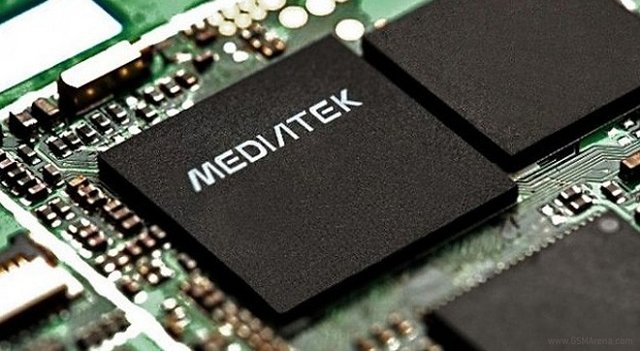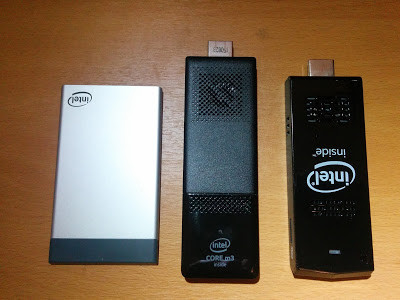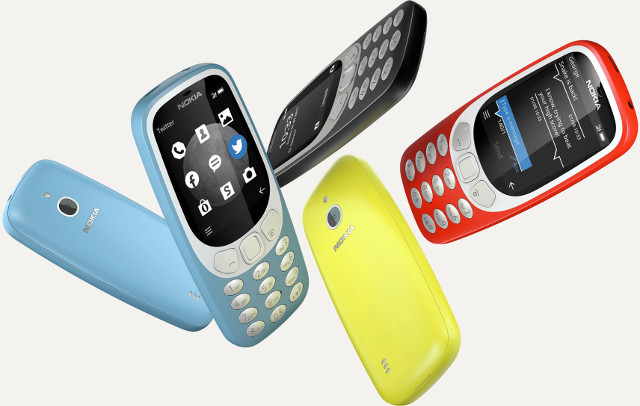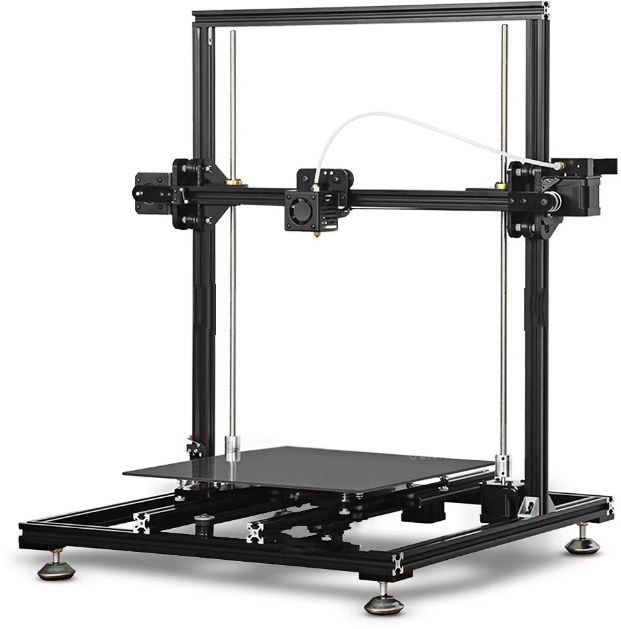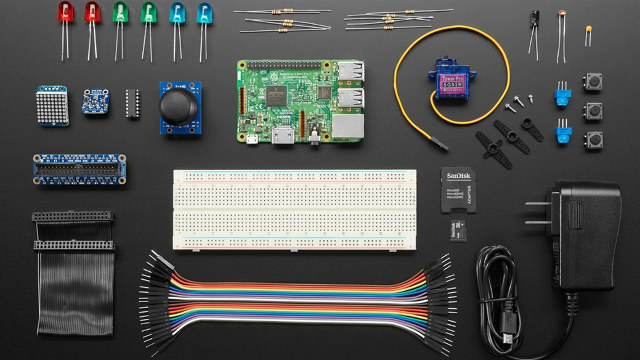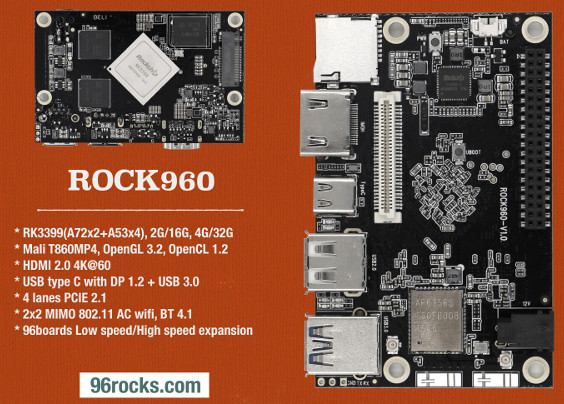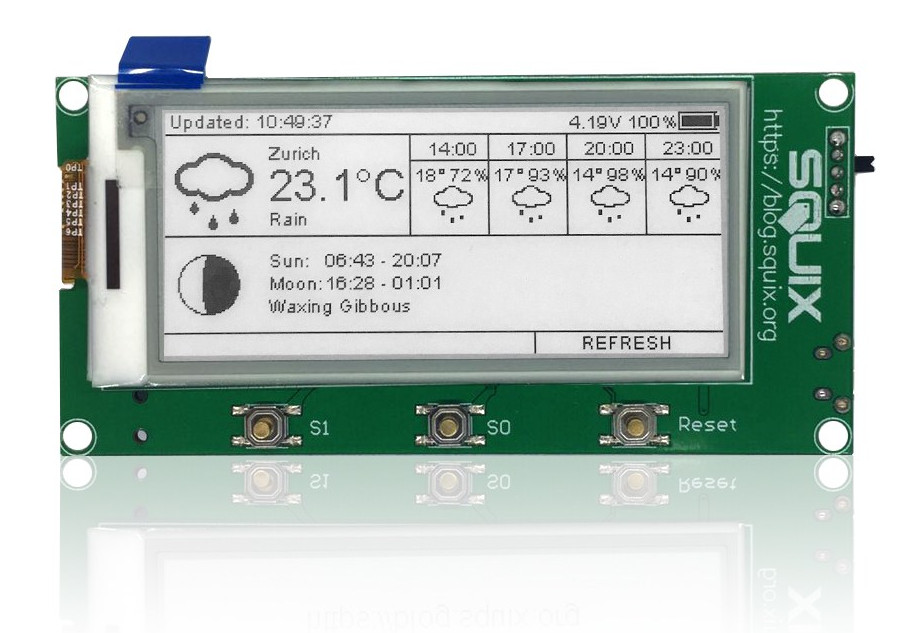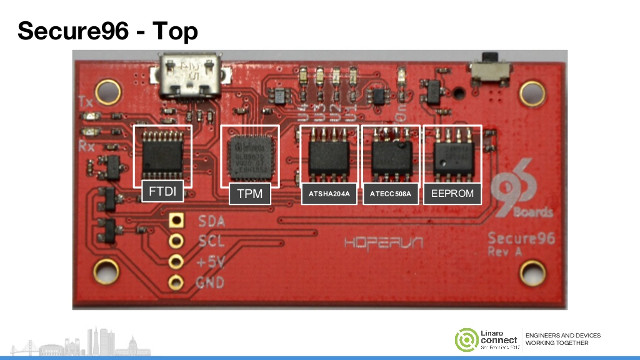India Mobile Congress 2017 took place in New Delhi this week, and at the event, Mediatek officially launched Helio P23 processor (in India), as well as a new MT6739 SoC with a quad core Cortex A53 processor, Imagination PowerVR GE8100 GPU, an a LTE Cat.4/5 modem for entry level 4G LTE smartphones. Mediatek MT6739 specifications: CPU – 4x ARM Cortex-A53 cores clocked up to 1.5GHz GPU – Imagination PowerVR GE8100 GPU @ 570 MHz with System Memory – LPDDR3-667MHz up to 3GB Storage – eMMC 5.1 Flash Display – up to 1440 x 720 (18:9 aspect ratio) Camera – 13MP, dual camera supported Video Decoding – 1080p @ 30FPS, H.264/HEVC Video Encoding – 1080p @ 30FPS, H.264 Modem – 4G LTE Cat. 4 DL / Cat. 5 UL (FDD/TDD) up to 150Mbps download, 50Mbps upload, CDMA2000, L+G, L+W/L+L DSDS, eMBMS, HPUE, 600MHz band supported; Dual VolTE Connectivity: Wi-Fi 802.11a/b/g/n, Bluetooth […]
Intel Compute Card and Dock Hands On, Windows 10 and Ubuntu Benchmarks
We’ve recently seen Intel introduced Dock DK132EPJ for their Compute Cards, and released some pricing info. Ian Morrison (Linuxium) got sent a full kit by Intel with the dock and Compute Card CD1M3128MK powered by a dual core / quad Core m3-7Y30 processor with 4GB RAM, 128GB PCIe SSD, and Intel Wireless-AC 8265 module. You can get the full details in Ian’s post, but I’ll provide a summary of the key points here. While the compute card and dock are thinner than most product, the computer card is quite wider than TV sticks, and the dock larger than an Intel NUC. It also comes with a fan, and cooling works well with maximum CPU temperature under being 70°C. The Compute Cards do not come with any operating system, but you get to the BIOS easily, and install Windows or Linux distributions. Ian’s started with Windows 10 Enterprise Evaluation, and ran […]
Nokia 3310 3G Dumb Phone Works with 2G & 3G Networks
Many people use smartphones now, but “dumb” feature phones are still being sold, as they are cheaper, some may find smartphones too complicated to use, while others wary about privacy issues. However, most feature phones comes with 2G connectivity, and with 2G sunset in many countries, I’ve recently realized it’s not so easy to find a simple phone with 3G cellular connectivity. The good news is that Nokia 3310 3G has just been announced by HMD global. Nokia 3310 3G specifications: SoC – TBD System Memory – TBD Storage – 64 MB storage; MicroSD card slot supporting up 32GB Display – 2.4” QVGA (320×240) color display Keyboard – “beautiful push buttons and iconic, shaped design” Camera – 2MP camera with LED flash Audio – Headphone jack Cellular Connectivity 2G/ 3G connectivity: dual band 900/1800 MHz +3G Band 1 and 8 (Single SIM) quad band GSM 850/900/1800/1900 + 3G Band 1, […]
Tronxy X3S 3D Printer Review – Part 1: Build and First Prints
Karl here with part 1 of Tronxy X3S build. It is another large volume printer to fully assemble on your own. Taking between 8-10 hours to put together. I have high hopes for this printer. Key things I like: metal frame, dual X, large build volume. Just from looking at it I don’t like the fact that it has no parts cooler but is easy to remedy. Tronxy X3S Specifications Let’s look at some specs. 300 x 300 x 400 mm hot bed (Actually get 330x330x400 build volume) Hot bed temperature: 40 – 110 Deg.C Nozzle temperature: 170-275 Degree Marlin 1.1.5 Frame material: Aluminum Extrusion I have not taken the hotend apart yet so not sure about the nozzle temperature going over 245°C. I will take it apart for the next part. If you are not familiar you don’t want to get lined nozzles above 245°C, or the lining starts […]
Google Cloud IoT Core Enters Public Beta, Various Devkits Available
Back in May, I wrote about Allwinner R18 based Banana Pi BPI-M64 Board with Google Cloud IoT Core support, as Google unveils the new cloud service during Google I/O. However, at the time it was only available to selected partners, and Google has recently launched the public beta making their IoT device management platform available to all. I first learned about this through an ARM community blog post announcing availability of the ARM-based IoT Kit for Cloud IoT Core on Adafruit using Raspberry Pi 3 board, a breadboard, and various modules that can be managed through Google services. But that are plenty of other IoT kits or boards for Google Cloud IoT Core including: Allwinner R18 based Pine A64-LTS, Banana Pi BPI-R18 Marvell based MACCHIATObin, and ESPRESSOBin boards Mongoose OS IoT starter kit with ESP32 board( instead of Raspberry Pi 3) Grove IoT Commercial Developer Kit based on Intel NUC […]
Rock960 Board is a 96Boards Compliant Board Powered by Rockchip RK3399 SoC
So it looks like Rockchip is soon going to join 96Boards family with Rock960 board. Developed by a Guangzhou based startup called Varms, the board will be powered by Rockchip RK3399 hexa-core SoC, and comply with 96Boards CE specifications. Rock960 board preliminary specifications: SoC – Rochchip RK3399 hexa-core big.LITTLE processor with two ARM Cortex A72 cores up to 1.8/2.0 GHz, four Cortex A53 cores @ 1.4 GHz, and ARM Mali-T860 MP4 GPU with OpenGL ES 1.1 to 3.2 support, OpenVG1.1, OpenCL 1.2 and DX 11 support System Memory – 2 or 4GB RAM Storage – 16 or 32GB eMMC flash + micro SD card Video Output – 1x HDMI 2.0 up to 4K@60 Hz with CEC and HDCP Connectivity – WiFi 802.11ac 2×2 MIMO up to 867 Mbps, and Bluetooth 4.1 LE (AP6356S module) with two on-board antennas, two u.FL antenna connectors USB – 1x USB 2.0 host port, 1x […]
2.9″ ESPaper Lite Kit is a $40 ePaper Display Kit with an ESP8266 WiFi Module
Squix (Daniel Eichhorn) has designed a 2.9″ ESPaper Lite Kite is a battery powered kit based on a black and white ePaper module, and ESP-WROOM-02 module based on Espressif Systems ESP8266 WiSoC. 2.9″ ESPaper Lite Kit specifications: Wireless Module – ESP-WROOM-02 WiFi module with Espressif ESP8266 Display – 2.9″ B&W ePaper module with 296×128 pixels resolution connect over SPI to ESP8266 Debugging / Programming – 6-pin serial port header USB – 1x micro USB port for programming Misc – 3 buttons: Reset (wake up from deep sleep); S0 (flash/GPIO0); S1: user button connected to GPIO12; power switch; charging and (firmware) flashing LEDs Power – JST connector for LiPo battery; charging circuit You’ll need a 3.3V USB to TTL debug board for flashing the firmware to the board, and a LiPo battery to power it up. The solution is particularly useful if you want a battery powered display that is infrequently […]
Secure96 is a 96Boards Mezzanine Expansion Board To Experiment with Hardware Based Security
With the Internet of things booming and taking a more important role in our lives, security will become more and more critical. So far, it has often been an afterthought with modems & routers frequently shipping with default username and password, and getting security right is really hard, as shown by the recent CLKSCREW attack that somehow leverages DVFS to break ARM TrustZone security, and that “is not a software bug, nor a hardware bug, it’s a fundamental part of the energy management design”, so most ARM platforms are vulnerable. Optimal security normally combines software and hardware, so having a platform to experiment with different HW security solutions would be useful, and that’s what Secure96 Mezzanine board for 96Boards aims for. Secure96 expansion board specifications: Security ICs Microchip Atmel ATSHA204A SHA-based CryptoAuthentication crypto element device Microchip Atmel ATECC508A crypto device with ECDH (Elliptic Curve Diffie–Hellman) key agreement Infineon SLB 9670 TPM […]


